10b - MN Results Reporting
Att10b_MN_Results_Commun_20120619.doc
Biomonitoring of Great Lakes Populations Program
10b - MN Results Reporting
OMB: 0923-0044
Attachment 10b (MN Appendix 12).
Attachment 10b. Minnesota Results Communications
Attachment 10b1. Clinical Results Letter
Attachment 10b2. Metals Rapid Results Materials
10b2a. Metals Rapid Results Protocol
10b2b. Rapid Results Letters (Tier 1)
Letter 1: Mercury > 5.8 µg/L (women of childbearing age)
Letter 2: Mercury > 17.4 µg/L (women of childbearing age)
Letter 3: Mercury > 17.4 µg/L (non-sensitive population)
Letter 4: Lead > 5 µg/dL
Letter 5: Cadmium > 1.7 µg/L
10b2c. Mercury Information Sheet
10b2d. Lead Information Sheet
10b2e. Cadmium Information Sheet
10b2f. FDL-MDH Fish Consumption Advisory Brochure
Attachment 10b3. Final Results Letters
10b3a. Letter 1: No rapid results letter sent/Hg below 5.8 ug/L
10b3b. Letter 2: Mercury rapid results letter sent
10b3c. Letter 3: Cadmium or lead rapid results letter sent
10b3d. Letter 4: No rapid results letter sent/Hg above 5.8 ug/L and below 17.4 ug/L
NOTE: State programs will work with their respective ethics sub-committees and ATSDR to improve and revise these letters. ATSDR and the states will take into consideration current guidelines via subject matter experts on the communication of results and potential follow-up with biomonitoring program respondents.
Attachment 10b1. Clinical Results Letter

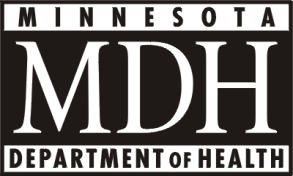
Fond du Lac Public Health Nursing Department
Fond du Lac Human Services Division
<Date>
<First Name> <Last Name>
<Address>
<Address2>
<City>, <State> <Zipcode>
Subject: Your results from the FDL Community Biomonitoring Study
Dear <First Name> <Last Name>,
Thank you for being part of the Fond du Lac Community Biomonitoring Study. We would like to share the first set of your results with you. Table 1 on page 3 shows your results.
The meaning of the measurements is below.
Body Mass Index (BMI): BMI is a measure of body fat. It is calculated using a person’s height and weight. People with a BMI over 30 are more likely to have health problems, such as type 2 diabetes and heart disease.
Waist Circumference: Waist circumference is the distance around the abdomen. People with a large waist are more likely to have health problems, such as type 2 diabetes and heart disease.
Blood Pressure: Blood pressure is the force of blood pushing against the walls of the arteries. "Systolic" pressure is when the heart squeezes (or “beats”) to pump blood. "Diastolic" pressure is when the heart rests between beats. High blood pressure can lead to heart disease, stroke, kidney failure, and other health problems.
Total cholesterol: This is a measure of good and bad forms of a waxy substance in your blood. People with high cholesterol are more likely to get heart disease. However, the test is most accurate after fasting (not eating or drinking for a certain amount of time before the test). If your cholesterol is high, we recommend you contact your health care provider to do a fasting test.
Hemoglobin A1C: A1C is a measure of how much glucose (sugar) was in the blood for about 90 days before the test. The result is shown as a percent. You do not need to fast before the A1C test. Doctors use this test to diagnose diabetes. An A1C level of 6.5 percent or higher on two separate tests means you have diabetes. A result between 5.7 and 6.4 percent means you may have pre-diabetes and a high risk of getting diabetes. For most people who have been told by a doctor they have diabetes, an A1C level of 6.5% or higher means you may need changes in your treatment plan to improve blood sugars and prevent complications from diabetes.
If you have questions, please contact Bonnie LaFromboise, the Public Health Nurse Consultant for the study. Her phone number is (218) 878-2132.
We will send the rest of your study results by the end of 2014. If you move, please call Rebecca Provost at (218) 879-1227 to tell us your new address.
Miigwech,
Chuck Ells
Associate Director
Fond du Lac Human Services
Fond du Lac Community Biomonitoring Study Results Report: Health Measures
Name:
Date of Clinic Visit Appointment:
Date Results Sent:
Table 1. Your Health Measures Results
Test |
Your Result |
What Your Result Means* |
||||||||||||||||||||
BMI |
<…..> |
<Normal (<25.0) > <Overweight (25.0 to 29.9) > <Obese (>30)> |
||||||||||||||||||||
Waist Circumference |
<…..> |
<Normal (≤ 40 inches for men and ≤35 inches for women, when BMI is <25)> <Increased risk of weight-related disease (>40 inches for men and >35 inches for women, when BMI is ≥25)> |
||||||||||||||||||||
Blood pressure |
<…..> |
|
||||||||||||||||||||
Total cholesterol |
<…..> |
<Normal (< 200 mg/dL )> <Borderline high (200-239 mg/dL)> <High (≥240 mg/dL)> |
||||||||||||||||||||
Hemoglobin A1C |
<…..> |
<Normal (<5.7%)> <If you have not been told by a doctor you have diabetes, your A1C level means that you may have pre-diabetes. If you have been told by a doctor you have diabetes, your A1C level means that your diabetes is under control (≥5.7 and <6.5%)> < If you have not been told by a doctor you have diabetes, your A1C level means that you may have diabetes. If you have been told by a doctor you have diabetes, your A1C level means that changes may need to be made to manage your glucose levels” (≥6.5%)> |
*The participant’s result for each measurement (“Your Result” column) will determine which description will appear in the “What Your Result Means” column.
Based on the “Your Result” column in Table 1, one of the following paragraphs will be inserted after the table…
Low risk paragraph template
Your results for all measurements were in the normal range. Based on this, we do not recommend you take any further action at this time.
Abnormal body measurement only paragraph template: BMI>30; BMI>25 and waist circumference >40 inches for men and >35 inches for women; or waist circumference >40 inches for men and >35 inches for women
People with <a BMI over 30><a BMI of 25 or higher and a waist circumference over 40 inches for men or over 30 inches for women ><a waist circumference over 40 inches for men or over 35 inches for women> are considered at risk for weight-related diseases such as high blood pressure, type 2 diabetes, and heart disease. If you would like to speak to a medical professional about your results, you may contact the study’s Public Health Nurse Consultant, Bonnie LaFromboise, at (218) 878-2132.
Moderate risk paragraph template: A1C≥5.7%-6.4%, TC=200-≤240 mg/dL, SBP 120 - ≤140 mmHg, DBP 80 - ≤90 mmHg
Based on your <A1C/TC/BP> result, we recommend you contact the study’s Public Health Nurse Consultant, Bonnie LaFromboise, at (218) 878-2132 to discuss your result and any actions you should take.
High risk paragraph template: A1C ≥ 6.5%, TC≥240 mg/dL, SBP>140 mmHg, DBP>90 mmHg
Based on your <A1C/TC/BP> result <we strongly recommend that you contact the study’s Public Health Nurse Consultant, Bonnie LaFromboise, at (218) 878-2132 (or) you will be contacted by the study’s Public Health Nurse Consultant, Bonnie LaFromboise> to discuss your results and further actions you should take. Or, you may follow up directly with your health care provider. Please bring this letter with you to your appointment.
Attachment 10b2. Metals Rapid Results Protocol, Letters and Information Sheets
10b2a. Metals Rapid Results Protocol
10b2b. Rapid Results Letters (Tier 1)
Letter 1: Mercury > 5.8 µg/L (women of childbearing age)
Letter 2: Mercury > 17.4 µg/L (women of childbearing age)
Letter 3: Mercury > 17.4 µg/L (non-sensitive population)
Letter 4: Lead > 5 µg/dL
Letter 6: Cadmium > 1.7 µg/L
10b2c, Mercury Information Sheet
10b2d. Lead Information Sheet
10b2e. Cadmium Information Sheet
10b2f. FDL-MDH Fish Consumption Advisory Brochure (included in mercury rapid results letter)
Note: The CDC National Health and Nutrition Examination Survey (NHANES) reference values based on adults (20 years and older) are subject to periodic updates. If updated, the reference ranges in the results letters will be revised to reflect the most recent values.
Metals Rapid Results Reporting: Protocol
I. Background
For most environmental chemicals in the FDL Community Biomonitoring study, we will not know if a biomonitoring result signifies a health risk. This is because very few biomarker-toxicity relationships have been established in epidemiologic studies. Currently, information on levels of chemicals in the body known to cause harm (based on human studies) is available for cadmium, lead, and mercury. However, there is little official guidance on “safe” levels, especially for the adult general population. For example, OSHA promulgates occupational standards for cadmium, mercury, and lead, but technical feasibility and the cost of compliance are factored into the standards, and they do not account for more vulnerable subpopulations or life stages in the general population. Or, guidance values have been determined for the most sensitive subpopulations only (mercury=pregnant women/infants/children lead=infants/children); none of which are included in the FDL Community Biomonitoring study.
MDH is proposing concentrations of cadmium, lead, and mercury that should prompt the reporting of results back to participants more rapidly (Section II). Note that there are no defined thresholds for health effects on which to base action levels. Diseases resulting from exposures to heavy metals typically proceed in stages: (1) normal, (2) physiological change of uncertain significance, (3) pathophysiological change, (4) overt symptoms (morbidity), and (5) mortality. Within this process there are no sharp distinctions, but rather a continuum of effects.
The action levels are presented in two tiers. The goal of communicating to participants above Tier 1 action levels is to prevent progression from stage 1 to stage 2/3. The goal of communicating to participants above Tier 2 action levels is to prevent progression from stage 1/2/3 to stage 2/3/4.
Tier 1 Action Levels
Tier 1 action levels are based on the lowest identified level of statistically significant increased risk for adverse human health effects demonstrated in epidemiologic studies. These levels are not expected to result in overt symptoms of metal poisoning and are not considered an immediate hazard to health. These levels are above the 95th percentile concentrations for adults in NHANES, so they are not expected to occur frequently. Cadmium Tier 1 level may be occasionally exceeded by heavy smokers. Based on results from other biomonitoring studies, roughly 10% of women of childbearing age may exceed the Tier 1 action level for mercury. We estimate approximately 145 women of childbearing age may be represented in the study (29% of Client List). This translate to ~15 women above the Hg action level. Note that effects relevant to early life (pregnancy and infants) were considered when selecting Tier 1 concentrations because women in the study could become pregnant after specimen collection.
If a participant’s result for Cd, Pb, or Hg is above the Tier 1 level, he/she will be notified rapidly by mail, within 3 weeks after results are received from the laboratory. The goal is to help the participant identify potential sources of exposure and provide information on how to reduce exposures. The public health nurse consultant’s name and contact information will be provided in the results letter. Standard templates will be developed for results letters. A factsheet will accompany the letter in the mailing. An MDH-FDL fish consumption advice brochure will accompany the mercury letter.
Tier 2 Action Levels
MDH is also proposing action levels of cadmium, lead, and mercury that should prompt additional intervention beyond those for Tier 1. Tier 2 levels are of greater concern for health based on effects seen on a population level in epidemiologic studies. These levels are not expected to result in overt symptoms of metal poisoning. It is anticipated that Tier 2 action levels will rarely be exceeded. Exceedences may be found in people who are occupationally exposed, eat a diet very high in fish (mercury) or organ meats (cadmium), or have contact with an uncommon source of exposure.
If a participant’s result for Cd, Pb, or Hg is above the Tier 2 level, he/she will be notified rapidly by mail, within 3 weeks after results are received from the laboratory. The goal is to help the participant identify potential sources of exposure and provide information on how to reduce exposures. The letter will appear similar to the Tier 1 letter with one exception. The participant will be told to expect a follow-up call from the public health nurse consultant. Her name and contact information will also be provided in the letter. A factsheet will accompany the letter in the mailing. A fish consumption advice brochure will accompany the mercury letter.
In contrast to Tier 1 “passive” reporting, exceedance of a Tier 2 action level will prompt a follow-up call from the public health nurse consultant. Prior to the phone call, the study questionnaire will be examined by MDH staff for information on exposure sources. The appropriate interventions to recommend during the phone call will be determined on a case-by-case basis. A medical consultant will be contacted for advice when necessary. Examples of interventions could include a recommendation for physician follow-up, laboratory test follow-up (e.g., urinary cadmium test, repeat blood test, beta-2 microglobulin test, etc.), healthy home/lead visit, smoking cessation, avoidance of certain medications (nephrotoxins, acetaminophen), diet/nutrient recommendations, or diabetes control.
Rapid results reporting for those who marked on the consent
form that they do not want a written report of their results: Results
reporting will take place by phone rather than by mail.
II. Metals
MDH proposes that the following metals concentrations should prompt rapid results reporting. An overview of the proposal is found in Figure 1.
Tier One Blood Lead: >5 µg/dL, based on the following:
According to the National Toxicology Program (NTP 2011), there is sufficient evidence that:
Blood Pb levels <5 μg/dL1 are associated with decreased renal function in adults. Diabetes is more prevalent in FDL Community than general population and can increase risk of Pb-related kidney effects.
Blood Pb levels <10μg/dL are associated with blood pressure, hypertension, and increased cardiovascular-related mortality in adults.
Maternal blood Pb levels <10μg/dL are associated with reduced fetal growth.
According to NTP, there is limited evidence that:
Maternal blood Pb levels <10μg/dL are associated with increased spontaneous abortion and preterm birth.
Blood Pb <10μg/dL is associated with decreased auditory function, neurodegenerative diseases, and decreases in measures of cognitive function in older adults.
5 µg/dL is consistent with guidance from CDC (CDC 2010) and an expert panel (Kosnett MJ et al. 2007) on the recommended medical management of lead in lactating women or women who may become pregnant.
Tier Two Blood Lead: >15 µg/dL, based on the following:
Non-sensitive adults:
For prevention of chronic health effects of cumulative dose, the available evidence suggests that tibia lead levels should not exceed 15 μg lead/g bone mineral, equivalent to average blood lead level of 15 μg/dL over 10-20 years or 10 μg/dL over 20-40 years (Schwartz and Hu 2007).
Expert panel convened by the Association of Occupational and Environmental Clinics recommends medical surveillance for lead-exposed workers with levels between 10 and 20 μg/dL based on increased risk of hypertension and kidney dysfunction, and possible subclinical neurocognitive deficits (Kosnett et al. 2007).
Additional concerns for women of childbearing age:
Expert panel convened by the Association of Occupational and Environmental Clinics reports increased risk of reduced birth weight and possible spontaneous abortion and postnatal developmental delay between 10-19 μg/dL (Kosnett et al. 2007).
Tier One Blood cadmium: >1.7 µg/L, based on the following:
The Occupational Safety and Health Administration (OSHA) considers a blood Cd level ≥5 μg/L to be hazardous to workers. 1.7 μg/L is equivalent to adding a 3x uncertainty factor to the OSHA value to account for adverse effects in the general population; which unlike a healthy worker population, includes vulnerable subpopulations. In particular, diabetes is more prevalent in the FDL Community than general population and can increase risk of Cd-related kidney effects.
1.7 μg/L is equivalent to EPA’s chronic Reference Dose2 for Cd (Hays et al. 2008).
Blood Cd levels < 5 μg/L are associated with increased risk of kidney and bone effects, diabetes, and hypertension, blood vessel and heart-related effects (Satarug et al. 2010).
Tier Two Blood cadmium: >5 µg/L, based on the following:
5 μg/L is the occupational level which triggers medical monitoring and discretionary medical removal (OSHA Standard 1910.1027 App A). ACGIH also proposed a BEI of 5 μg/L.
Represents a concentration that should “trigger actions to protect the kidney from damage”. (OSHA Standard 1910.1027 App A).
Corresponds to 1/2 of the “critical level” (the level where the concentration in the renal cortex reaches 200 ppm) where irreversible proteinuria is likely to develop in 10% of exposed subjects. See: http://www.osha.gov/pls/oshaweb/owadisp.show_document?p_table=preambles&p_id=819
Tier Two Blood mercury (No Tier 1 levels): >5.8 μg/L for women of reproductive age (18-44); >17.4 μg/L for all other adults, based on the following:
Results above these action levels should always prompt evaluation of the questionnaire for exposure sources (Tier 2) because health effects and risks highly depend upon the form of mercury.
The action levels are based on methylmercury. Inorganic Hg is not captured in blood unless exposure occurred in the past day or two. If the questionnaire indicates little to no fish consumption, follow-up with the participant will take place on a case-by-case basis (see Figure 2).
5.8 μg/L is the maternal blood methlymercury level corresponding to EPA’s reference dose for developmental effects. 17.4 μg/L corresponds to the 1995 EPA methylmercury reference dose based on CNS effects in the adult non-sensitive population. The lower level is necessary for women who may become pregnant due to the fetus’s increased sensitivity for nervous system effects.
The action levels were chosen to be consistent with current FDL and MDH fish consumption advice. FDL and MDH provide fish consumption guidelines that result in blood Hg levels below 5.8 μg/L for women of childbearing age and below 17.4 μg/L for all other adults.
Mercury Speciation:
The inorganic Hg concentration may prompt additional follow-up with the participant on a case-by-case basis (see Figure 2).
III. References
CDC. Guidelines for the Identification and Management of Lead Exposure in Pregnant and Lactating Women. http://www.cdc.gov/nceh/lead/publications/LeadandPregnancy2010.pdf
Hays SM, Nordberg M, Yager JW, Aylward LL. Biomonitoring equivalents dossier for cadmium. Reg Tox and Pharm 51: S49-S56. 2008.
Kosnett MJ, Wedden RP, Rothenberg SJ, et al. Recommendations for medical management of adult lead exposure. Environ Health Perspect 115:463–471. 2007.
National Toxicology Program, U.S. Department of Health and Human Services. Draft NTP Monograph on Health Effects of Low-level Lead. Oct 14, 2011. http://ntp.niehs.nih.gov/NTP/ohat/Lead/DraftNTPMonographonHealthEffectsofLowLevelLead.pdf
Satarug S, Garrett S, Sens MA and Sens DA. Cadmium, environmental exposure, and health outcomes. Environ Health Perspect 118:182-190. 2010.
Schwartz BS, Hu H 2007. Adult Lead Exposure: Time for Change. Environ Health Perspect 115:451-454. http://dx.doi.org/10.1289/ehp.9782
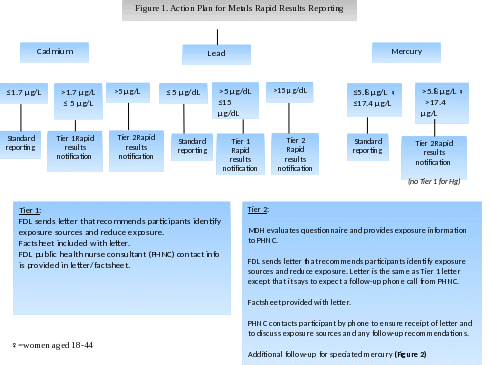
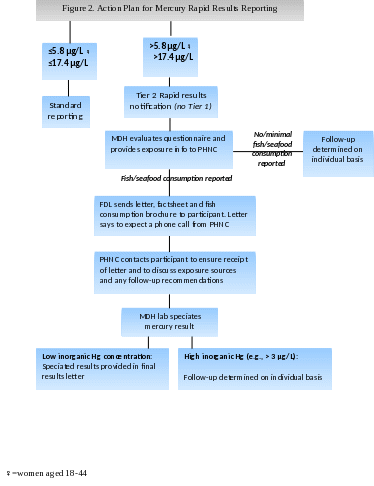


Fond du Lac Public Health Nursing Department
Fond du Lac Human Services Division
<Date>
<First Name> <Last Name>
<Address>
<Address2>
<City>, <State> <Zipcode>
Dear <First Name>,
Thank you for being part of the Fond du Lac Community Biomonitoring Study. We are contacting women of childbearing age who have more than 5.8 micrograms of mercury per liter of blood. This amount may increase the risk of health problems in an unborn baby.
Testing of your blood found < …> micrograms of mercury per liter of blood.
Your result shows you are exposed to more mercury than is usual. However, it does not mean you are sick, or you will get sick. If there is no chance that you will get pregnant, this amount in your blood is not considered harmful to you.
Information about mercury is enclosed. Please read this sheet and:
Look for ways you may be exposed to mercury.
Take steps to lower your exposure if you are pregnant or planning a pregnancy.
If you have questions about your result, you may contact Bonnie LaFromboise, the Public Health Nurse Consultant for the study. Her phone number is (218) 878-2132.
If you move, please call Rebecca Provost at (218) 879-1227 to tell us your new address. We will send the rest of your study results by the end of 2014.
Miigwech,
Chuck Ells
Associate Director
Fond du Lac Human Services


Fond du Lac Public Health Nursing Department
Fond du Lac Human Services Division
<Date>
<First Name> <Last Name>
<Address>
<Address2>
<City>, <State> <Zipcode>
Dear <First Name>,
Thank you for being part of the Fond du Lac Community Biomonitoring Study. We are contacting people who have more than 17.4 micrograms of mercury per liter of blood. This amount may increase the risk of health problems.
Testing of your blood found < …> micrograms of mercury per liter of blood.
Your result shows you are exposed to more mercury than is usual. However, it does not mean you are sick, or you will get sick.
Information about mercury is enclosed. Please read this sheet and:
Look for ways you may be exposed to mercury.
Take steps to lower your exposure, especially if you are pregnant or planning a pregnancy.
If you have questions about your result, you may contact Bonnie LaFromboise, the Public Health Nurse Consultant for the study. Her phone number is (218) 878-2132.
If you move, please call Rebecca Provost at (218) 879-1227 to tell us your new address. We will send the rest of your study results by the end of 2014.
Miigwech,
Chuck Ells
Associate Director
Fond du Lac Human Services


Fond du Lac Public Health Nursing Department
Fond du Lac Human Services Division
<Date>
<First Name> <Last Name>
<Address>
<Address2>
<City>, <State> <Zipcode>
Dear <First Name>,
Thank you for being part of the Fond du Lac Community Biomonitoring Study. We are contacting people who had more than 17.4 micrograms of mercury per liter of blood. This amount may increase the risk of health problems.
Testing of your blood showed < …> micrograms of mercury per liter of blood.
Your result shows you are exposed to more mercury than is usual. However, it does not mean you are sick, or you will get sick.
Information about mercury is enclosed. Please read this sheet and:
Look for ways you may be exposed to mercury.
Take steps to lower your exposure.
If you have questions about your result, you may contact Bonnie LaFromboise, the Public Health Nurse Consultant for the study. Her phone number is (218) 878-2132.
If you move, Please call Rebecca Provost at (218) 879-1227 to tell us your new address. We will send the rest of your study results by the end of 2014.
Miigwech,
Chuck Ells
Associate Director
Fond du Lac Human Services


Fond du Lac Public Health Nursing Department
Fond du Lac Human Services Division
<Date>
<First Name> <Last Name>
<Address>
<Address2>
<City>, <State> <Zipcode>
Dear <First Name>,
Thank you for being part of the Fond du Lac Community Biomonitoring Study. We are contacting people who had more than 5 micrograms of lead per deciliter of blood. This amount may increase the risk of health problems.
Testing of your blood found < …> micrograms of lead per deciliter of blood.
Your result shows you are exposed to more lead than is usual. However, it does not mean you are sick, or you will get sick.
Information about lead is enclosed. Please read this sheet and:
Look for ways you may be exposed to lead.
Take steps to lower your exposure.
If you are pregnant or caring for a young child, it is especially important to identify ways you are exposed to lead. Unborn babies and young children are more sensitive to lead and may be exposed to lead in the same way as you.
If you have questions about your result, you may contact Bonnie LaFromboise, the Public Health Nurse Consultant for the study. Her phone number is (218) 878-2132.
If you move, please call Rebecca Provost at (218) 879-1227 to tell us your new address. We will send the rest of your study results by the end of 2014.
Miigwech,
Chuck Ells
Associate Director
Fond du Lac Human Services


Fond du Lac Public Health Nursing Department
Fond du Lac Human Services Division
<Date>
<First Name> <Last Name>
<Address>
<Address2>
<City>, <State> <Zipcode>
Dear <First Name>,
Thank you for being part of the Fond du Lac Community Biomonitoring Study. We are contacting people who had more than 1.7 micrograms of cadmium per liter of blood. This amount may increase the risk of health problems.
Testing of your blood found < …> micrograms of cadmium per liter of blood.
Your result shows you are exposed to more cadmium than is usual. However, it does not mean you are sick, or you will get sick.
Information about cadmium is enclosed. Please read this sheet and:
Look for ways you may be exposed to cadmium.
Take steps to lower your exposure.
If you have questions about your result, you may contact Bonnie LaFromboise, the Public Health Nurse Consultant for the study. Her phone number is (218) 878-2132.
If you move, please call Rebecca Provost at (218) 879-1227 to tell us your new address. We will send the rest of your study results by the end of 2014.
Miigwech,
Chuck Ells
Associate Director
Fond du Lac Human Services
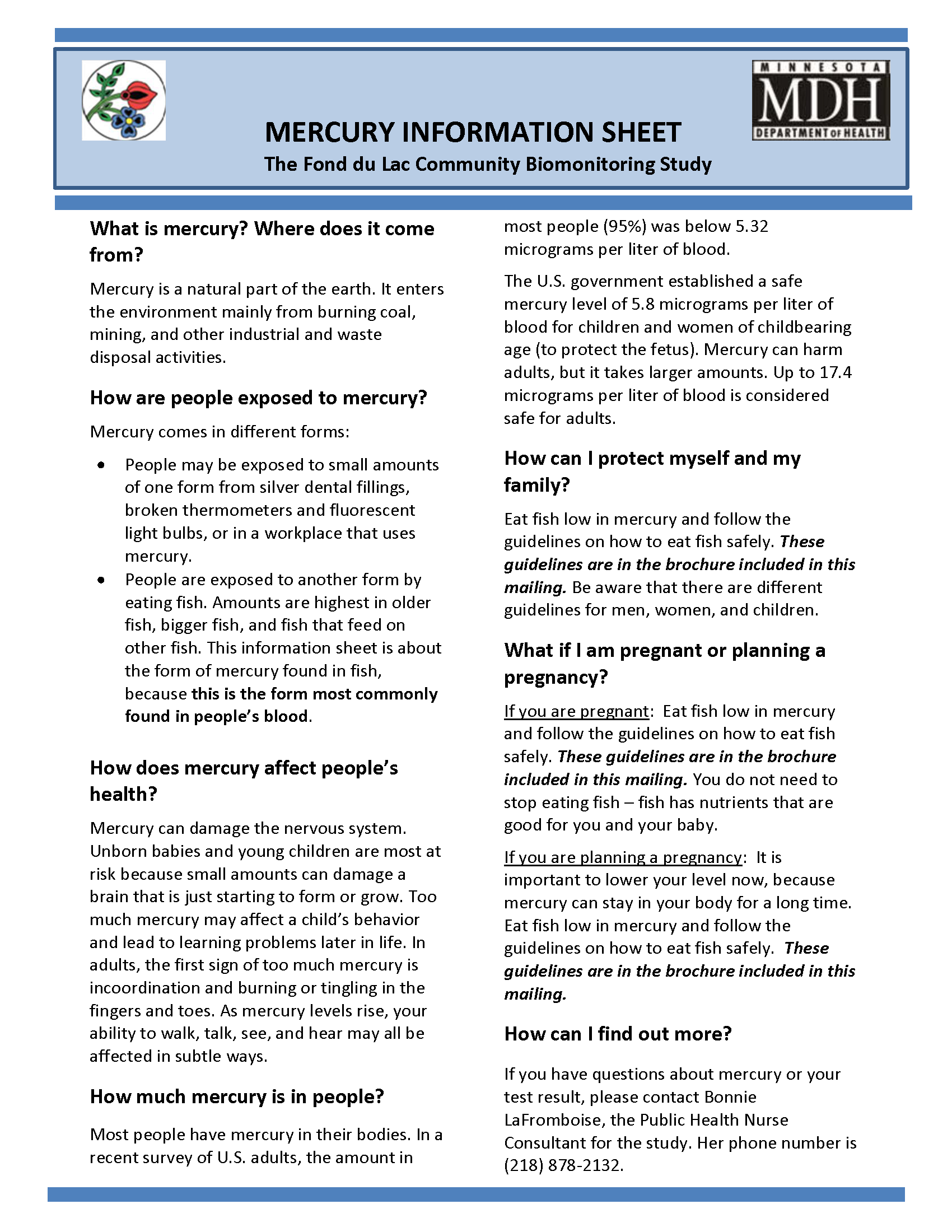
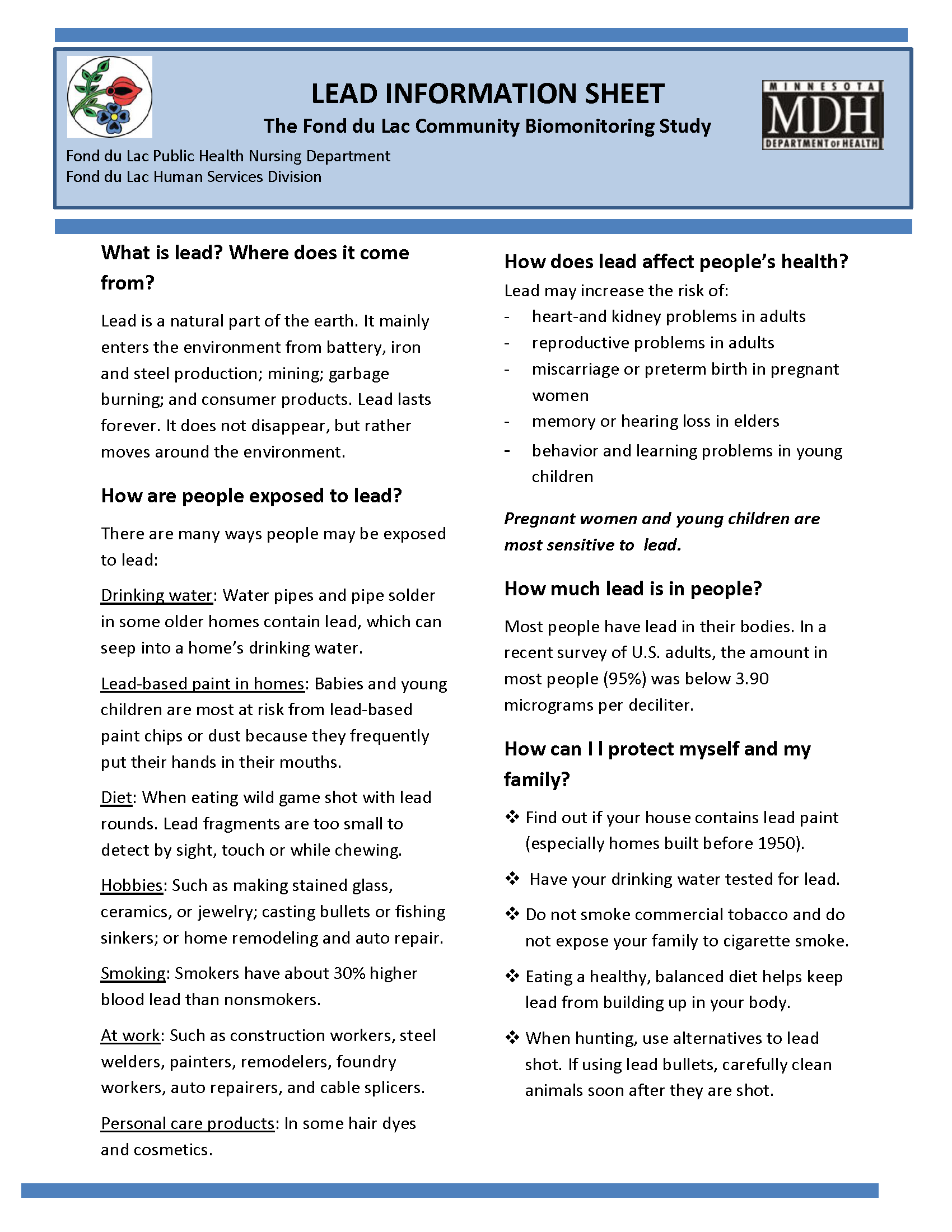
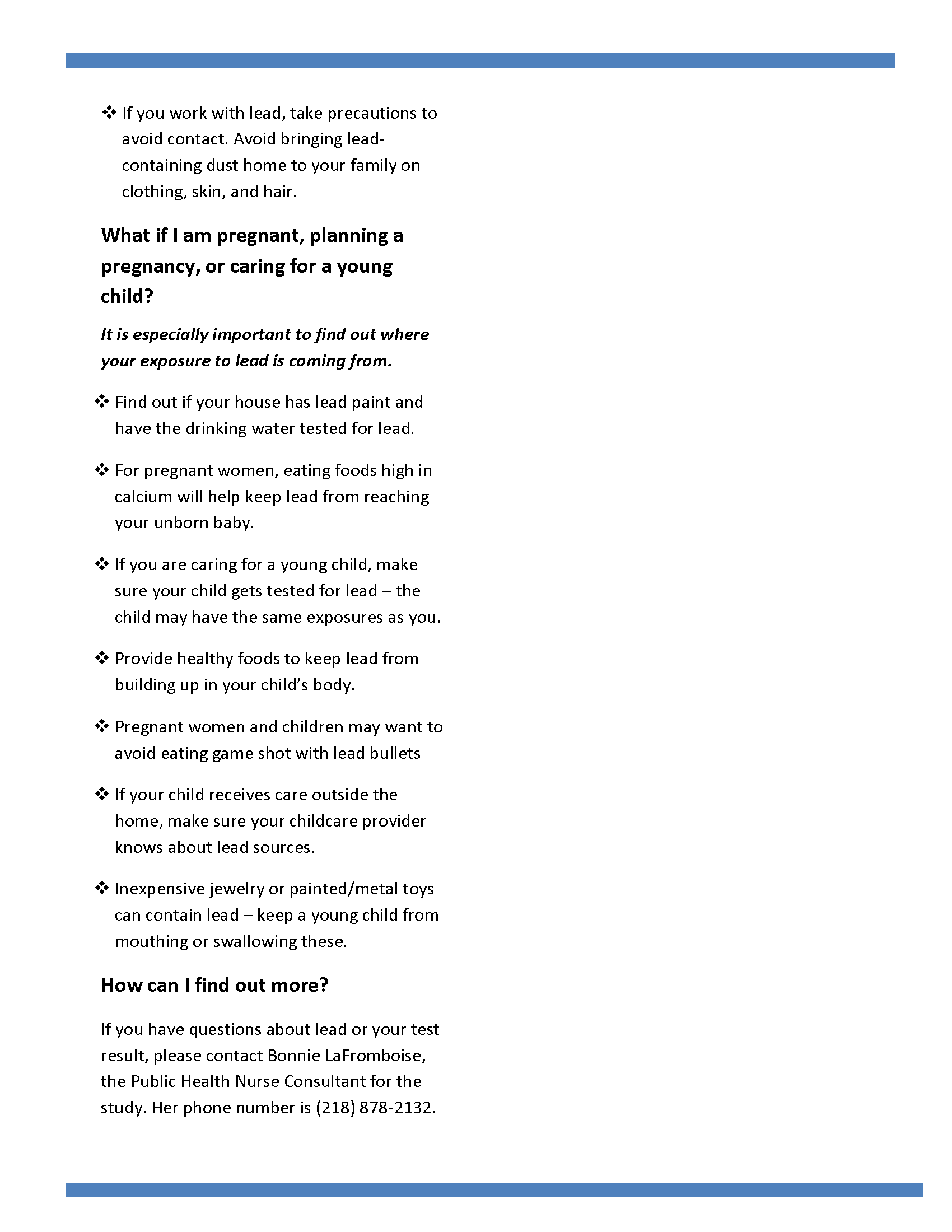
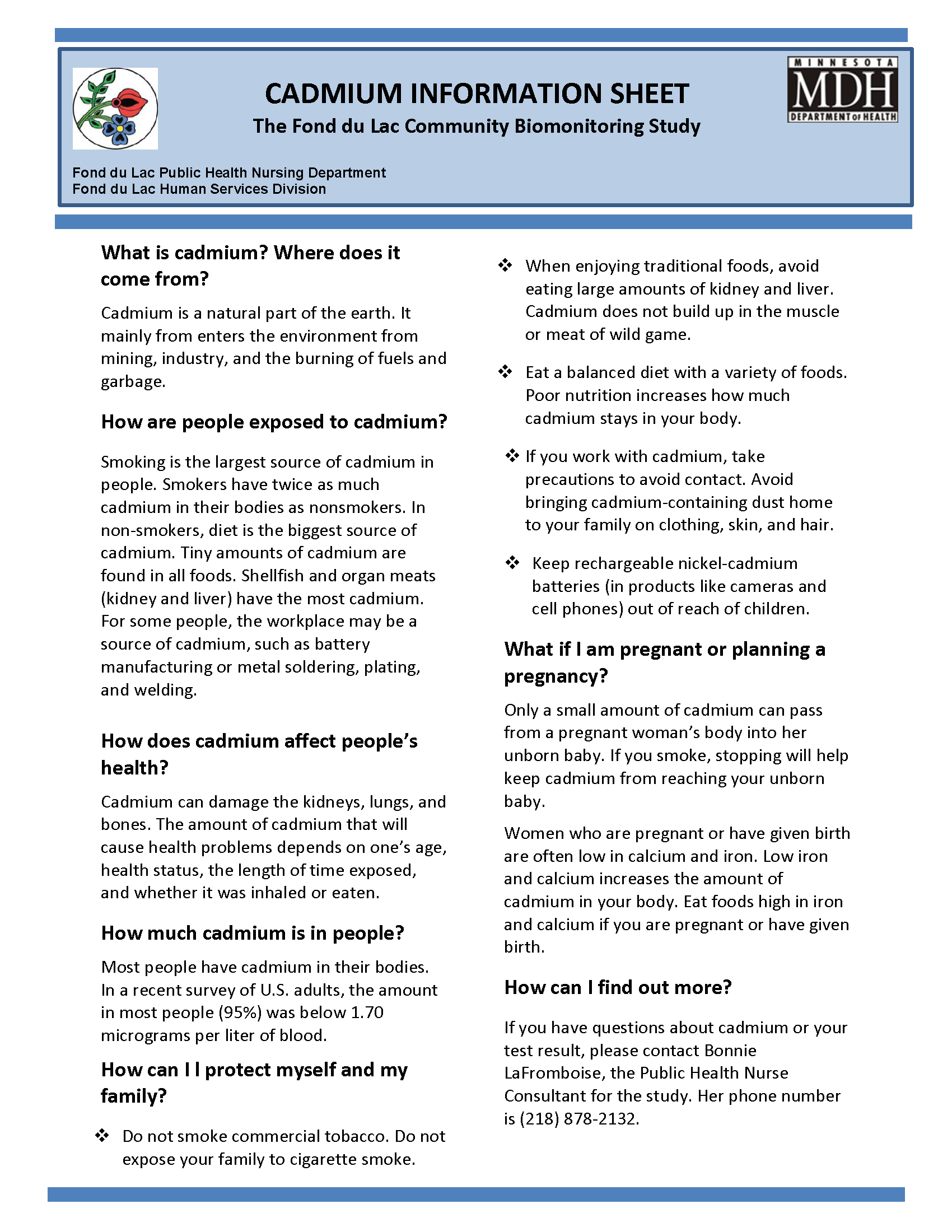

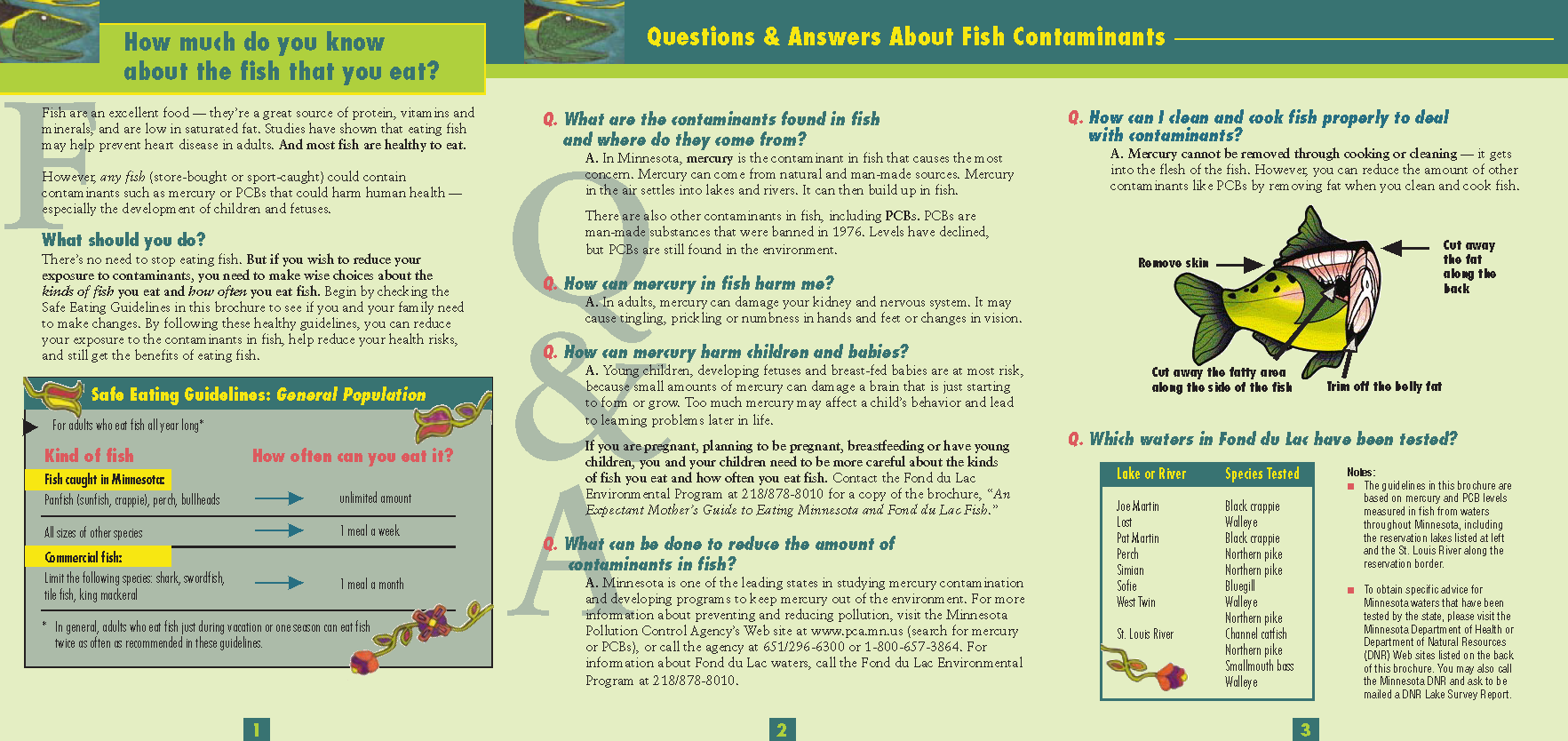
Attachment 10b3 (MN Appendix 12.3): Final Results Letters
10b3a. Final results letter 1: No rapid results letter sent/Hg below 5.8 ug/L
10b3b. Final results letter 2: Mercury rapid results letter sent
10b3c. Final results letter 3: Cadmium or lead rapid results letter sent
10b3d. Final results letter 4: No rapid results letter sent/Hg above 5.8 ug/L and below 17.4 ug/L
Note: The CDC National Health and Nutrition Examination Survey (NHANES) reference values based on adults (20 years and older) are subject to periodic updates. If updated, the reference ranges in the results letters will be revised to reflect the most recent values.
Results from the First Nations Biomonitoring Initiative (FNBI) are expected to be released by the end of 2013. A footnote to Table 1 providing FNBI reference values for toxaphene, selenium, cotinine may be added, as NHANES values are unavailable.


Fond du Lac Public Health Nursing Department
Fond du Lac Human Services Division
<Date>
<First Name> <Last Name>
<Address>
<Address2>
<City>, <State> <Zipcode>
Subject: Your Biomonitoring Study Results
Dear <First Name> <Last Name>,
Thank you for being part of the Fond du Lac (FDL) Community Biomonitoring Study. Earlier, we sent your results for total cholesterol, hemoglobin A1C, blood pressure, and body measurements. We also tested your blood and urine for several environmental chemicals and some nutrients found in fish. Tables 1 and 2 show your results and are described below.
Table 1 (Environmental Chemicals)
Chemical (column 1 – white): name of the chemical tested
Your Results (column 2 – light grey): amount of chemical found in your blood or urine
Study Results (column 3 – medium grey): summary results for the FDL Community Biomonitoring Study
50th percentile: half of all people in this study had a result below this number.
95th percentile: most (ninety-five percent) of all people in this study had a result below this number.
Range: the lowest and highest number found in people in the study
U.S. Results (column 4 – dark grey): the most recent summary results from a study of people who live all over the U.S (the National Health and Nutrition Examination Survey).The samples were taken from adults (age 20 and greater) in years 2003-2008.
50th percentile: half of all people in the U.S. study had a result below this number.
95th percentile: one of the highest results found in the U.S. study. Ninety-five percent of people had a result below this number.
Table 2 (Nutrients)
Chemical (column 1 – white): name of the chemical tested
Your Results (column 2 – light grey): amount of chemical found in your blood or urine
Study Results (column 3 – medium grey): summary results for the FDL Community Biomonitoring Study
Standard Values: most (ninety-five percent) of all people in this study had a result between these numbers.
Range: the lowest and highest number found in people in the study
U.S. Results (column 4 – dark grey): the most recent summary results from a study of people who live all over the U.S (the National Health and Nutrition Examination Survey).The samples were taken from adults (age 20 and greater) in years 2003-2008.
Standard Values: most (ninety-five percent) of all people in the U.S. study had a result between these numbers.
Table 3 (Chemical Description)
This table was in the study Informed Consent Brochure. It shows what each chemical is and how a person may come into contact with it. This information may be helpful if you would like to
lower your exposure to chemicals found in your blood or urine.
If any of your environmental chemical results are higher than the FDL study or U.S. 95th percentile, it does not mean you will have health problems. Scientists are still learning if these chemicals cause harm in the amounts usually found in people.
If any of your nutrient results are higher or lower than the FDL or the U.S. standard values, it does not mean you will have health problems. These are helpful ways we look at fish in your diet.
If you have questions, please contact Bonnie LaFromboise, the Public Health Nurse Consultant for the study. Her phone number is (218) 878-2132.
Miigwech,
Chuck Ells
Associate Director
Fond du Lac Human Services
Fond du Lac Community Biomonitoring Study Results Report
Name:
Date of Clinic Visit Appointment:
Date Results Sent:

Table 1: Biomonitoring Results: Environmental Chemicals*
Chemical Measured |
Your Results |
Study Results: 50th-95th percentile (range) |
U.S. Results: 50th-95th percentile |
Mercury, in blood |
|
|
0.89-5.32 |
Cadmium, in blood |
|
|
0.33-1.70 |
Lead, in blood |
|
|
1.34-3.90 |
Mirex, in blood |
|
|
**-15.4 |
Hexachlorobenzene, in blood |
|
|
15.1-29.0 |
p,p’-DDT, in blood |
|
|
**-20.7 |
o,p’-DDT, in blood |
|
|
**-** |
p,p’-DDE, in blood |
|
|
233-1990 |
Toxaphene, in blood |
|
|
*** |
Total PCBs, in blood |
|
|
TBD |
Perfluorinated chemicals, in blood |
|
||
PFOA |
|
|
4.30-9.80 |
PFOS |
|
|
14.0-42.8 |
PFBA |
|
|
*** |
PFHxS |
|
|
1.9-9.0 |
PFBS |
|
|
**-** |
PFHxA |
|
|
*** |
PFPeA |
|
|
*** |
PFNA |
|
|
1.5-4.1 |
1-hydroxypyrene, in urine |
|
|
73.5-424 |
Bisphenol A, in urine |
|
|
1.92-9.32 |
Triclosan, in urine |
|
|
12.6-484 |
Cotinine, in urine |
|
|
*** |
*Mercury and cadmium are reported in micrograms per liter of blood. Lead is reported in micrograms per deciliter of blood. Mirex, hexachlorobenzene, DDT, DDE, toxaphene and PCBs are reported in nanograms per gram of lipid in blood serum. Perfluorinated chemicals are reported as micrograms per liter of blood serum. 1-hydroxypyrene is reported as nanogram per gram of creatinine. Bisphenol A, triclosan, cotinine are reported in micrograms per gram of creatinine.
**Too low to be measured or calculated (your results or the 50th or 95th percentile)
***Not included in the U.S. (NHANES) study
Table 2: Biomonitoring Results: Nutrients*
Chemical Measured |
Your Results |
Study Results: Standard Values (range) |
U.S. Results: Standard Values |
Selenium, in urine |
|
|
*** |
Polyunsaturated fatty acids, in blood |
|
||
Eicosapentaenoic acid (EPA) |
|
|
14.8-151 |
Docosahexaenoic acid (DHA) |
|
|
54.9-323 |
Docosatetraenoic acid |
|
|
12.1-47.7 |
Docosapentaenoic acid (DPA) |
|
|
22.1-82.9 |
Gamma-Linoleic acid |
|
|
17.1-117 |
Alpha-Linoleic acid |
|
|
25.2-165 |
Homo-gamma-Linoleic acid |
|
|
73.2-289 |
Arachnidonic acid (AA) |
|
|
445-1320 |
Linoleic acid (LA) |
|
|
2210-5410 |
*Selenium is reported in micrograms per liter of urine. Polyunsaturated fatty acids are reported in micromoles per liter of blood plasma. U.S. fatty acid values are fasting results.
***Not included in the U.S. (NHANES) study. The Mayo Clinic reports standard values of selenium in urine as 15-50 micrograms per liter of urine.
Table 3: What We Measured in Blood and Urine (from Study Consent Brochure)
Environmental Chemical |
What is it? How are we exposed? |
Cadmium |
A metal. Most exposure occurs through food or cigarette smoking. |
Mercury |
A metal. Most likely to be exposed by eating fish. |
Lead |
A metal. People may be exposed through air, soil, house dust, food, drinking water, and consumer products. |
Mirex |
A pesticide and flame retardant (currently banned). Most likely to be exposed by eating fish. |
Hexachlorobenzene |
A pesticide (currently banned). Also a waste product from some industries and trash burning. Most exposure is through food, especially fish. |
DDT and DDE |
A pesticide and its breakdown product (currently banned). Most exposure is through food, especially meat and dairy. |
Toxaphene |
A pesticide (currently banned). Exposure is mainly through food, particularly fish. |
Polychlorinated biphenyls (PCBs) |
A group of industrial chemicals (currently banned). Most exposure occurs through food. |
1-hydroxypyrene |
One in a group of chemicals called polycyclic aromatic hydrocarbons (PAHs). Exposure may occur from tobacco smoking, breathing indoor and outdoor air, and eating char-broiled meats and fish. PAHs are also contaminants of concern at local Superfund sites. |
Perfluorinated compounds (PFOA, PFOS, PFBA, PFHxS, PFBS, PFHxA, PFPeA) |
A group of chemicals used in products to resist heat, stains, or moisture. Exposure may occur through food, drinking water, and contact with consumer products. |
Bisphenol A |
A chemical found in plastics and food/beverage can linings. Most exposure likely occurs through food. May be present in Minnesota surface water. |
Triclosan |
A chemical found in consumer and personal care products. |
Cotinine |
Formed when body breaks down nicotine. Used to determine if PAHs, cadmium, and other chemicals in the body are from the environment or tobacco products. |
Nutrients and Other Chemicals |
|
Selenium |
Essential mineral in our diet. Fish are high in selenium. |
Polyunsaturated fatty acids |
Beneficial chemicals in fish and plant/seed/nut oils. Essential for brain function and normal growth and development. Important for cardiovascular health. |
Creatinine |
A natural by-product in the body, used to interpret the level of chemicals in urine. |


Fond du Lac Public Health Nursing Department
Fond du Lac Human Services Division
<Date>
<First Name> <Last Name>
<Address>
<Address2>
<City>, <State> <Zipcode>
Subject: Your Biomonitoring Study Results
Dear <First Name> <Last Name>,
Thank you for being part of the Fond du Lac (FDL) Community Biomonitoring Study. Earlier, we sent your results for total cholesterol, hemoglobin A1C, blood pressure, and body measurements. We also sent you a letter about your level of mercury because it was higher than normal and could increase the risk of health problems. We tested your blood and urine for several environmental chemicals and some nutrients found in fish. Tables 1 and 2 show your results and are described below.
Table 1 (Environmental Chemicals)
Chemical (column 1 – white): name of the chemical tested
Your Results (column 2 – light grey): amount of chemical found in your blood or urine
Study Results (column 3 – medium grey): summary results for the FDL Community Biomonitoring Study
50th percentile: half of all people in this study had a result below this number.
95th percentile: most (ninety-five percent) of all people in this study had a result below this number.
Range: the lowest and highest number found in people in the study
U.S. Results (column 4 – dark grey): the most recent summary results from a study of people who live all over the U.S (the National Health and Nutrition Examination Survey).The samples were taken from adults (age 20 and greater) in years 2003-2008.
50th percentile: half of all people in the U.S. study had a result below this number.
95th percentile: one of the highest results found in the U.S. study. Ninety-five percent of people had a result below this number.
Table 2 (Nutrients)
Chemical (column 1 – white): name of the chemical tested
Your Results (column 2 – light grey): amount of chemical found in your blood or urine
Study Results (column 3 – medium grey): summary results for the FDL Community Biomonitoring Study
Standard Values: most (ninety-five percent) of all people in this study had a result between these numbers.
Range: the lowest and highest number found in people in the study
U.S. Results (column 4 – dark grey): the most recent summary results from a study of people who live all over the U.S (the National Health and Nutrition Examination Survey).The samples were taken from adults (age 20 and greater) in years 2003-2008.
Standard Values: most (ninety-five percent) of all people in the U.S. study had a result between these numbers.
Table 3 (Chemical Description)
This table was in the study Informed Consent Brochure. It shows what each chemical is and how a person may come into contact with it. This information may be helpful if you would like to
lower your exposure to chemicals found in your blood or urine.
If any of your environmental chemical results are higher than the FDL study or U.S. 95th percentile, it does not mean you will have health problems. Scientists are still learning if these chemicals cause harm in the amounts usually found in people.
If any of your nutrient results are higher or lower than the FDL or the U.S. standard values, it does not mean you will have health problems. These are helpful ways we look at fish in your diet.
If you have questions, please contact Bonnie LaFromboise, the Public Health Nurse Consultant for the study. Her phone number is (218) 878-2132.
Miigwech,
Chuck Ells
Associate Director
Fond du Lac Human Services
Fond du Lac Community Biomonitoring Study Results Report
Name:
Date of Clinic Visit Appointment:
Date Results Sent:

Table 1: Biomonitoring Results: Environmental Chemicals*
Chemical Measured |
Your Results |
Study Results: 50th-95th percentile (range) |
U.S. Results: 50th-95th percentile |
Mercury, in blood |
|
|
0.89-5.32 |
Methyl mercury |
|
|
*** |
Inorganic mercury |
|
|
**-0.700 |
Cadmium, in blood |
|
|
0.33-1.70 |
Lead, in blood |
|
|
1.34-3.90 |
Mirex, in blood |
|
|
**-15.4 |
Hexachlorobenzene, in blood |
|
|
15.1-29.0 |
p,p’-DDT, in blood |
|
|
**-20.7 |
o-p’-DDT, in blood |
|
|
**-** |
p,p’-DDE, in blood |
|
|
233-1990 |
Toxaphene, in blood |
|
|
*** |
Total PCBs, in blood |
|
|
TBD |
Perfluorinated chemicals, in blood |
|
||
PFOA |
|
|
4.30-9.80 |
PFOS |
|
|
14.0-42.8 |
PFBA |
|
|
*** |
PFHxS |
|
|
1.9-9.0 |
PFBS |
|
|
**-** |
PFHxA |
|
|
*** |
PFPeA |
|
|
*** |
PFNA |
|
|
1.5-4.1 |
1-hydroxypyrene, in urine |
|
|
73.5-424 |
Bisphenol A, in urine |
|
|
1.92-9.32 |
Triclosan, in urine |
|
|
12.6-484 |
Cotinine, in urine |
|
|
*** |
*Mercury and cadmium are reported in micrograms per liter of blood. Lead is reported in micrograms per deciliter of blood. Mirex, hexachlorobenzene, DDT, DDE, toxaphene and PCBs are reported in nanograms per gram of lipid in blood serum. Perfluorinated chemicals are reported as micrograms per liter of blood serum. 1-hydroxypyrene is reported as nanogram per gram of creatinine. Bisphenol A, triclosan, cotinine are reported in micrograms per gram of creatinine.
**Too low to be measured or calculated (your results or the 50th or 95th percentile)
***Not included in the U.S. (NHANES) study
Table 2: Biomonitoring Results: Nutrients*
Chemical Measured |
Your Results |
Study Results: Standard Values (range) |
U.S. Results: Standard Values |
Selenium, in urine |
|
|
*** |
Polyunsaturated fatty acids, in blood |
|
||
Eicosapentaenoic acid (EPA) |
|
|
14.8-151 |
Docosahexaenoic acid (DHA) |
|
|
54.9-323 |
Docosatetraenoic acid |
|
|
12.1-47.7 |
Docosapentaenoic acid (DPA) |
|
|
22.1-82.9 |
Gamma-Linoleic acid |
|
|
17.1-117 |
Alpha-Linoleic acid |
|
|
25.2-165 |
Homo-gamma-Linoleic acid |
|
|
73.2-289 |
Arachnidonic acid (AA) |
|
|
445-1320 |
Linoleic acid (LA) |
|
|
2210-5410 |
*Selenium is reported in micrograms per liter of urine. Polyunsaturated fatty acids are reported in micromoles per liter of blood plasma. U.S. fatty acid values are fasting results.
***Not included in the U.S. (NHANES) study. The Mayo Clinic reports standard values of selenium in urine as 15-50 micrograms per liter of urine.
Table 3: What We Measured in Blood and Urine (from Study Consent Brochure)
Environmental Chemical |
What is it? How are we exposed? |
Cadmium |
A metal. Most exposure occurs through food or cigarette smoking. |
Mercury |
A metal. Most likely to be exposed by eating fish. |
Lead |
A metal. People may be exposed through air, soil, house dust, food, drinking water, and consumer products. |
Mirex |
A pesticide and flame retardant (currently banned). Most likely to be exposed by eating fish. |
Hexachlorobenzene |
A pesticide (currently banned). Also a waste product from some industries and trash burning. Most exposure is through food, especially fish. |
DDT and DDE |
A pesticide and its breakdown product (currently banned). Most exposure is through food, especially meat and dairy. |
Toxaphene |
A pesticide (currently banned). Exposure is mainly through food, particularly fish. |
Polychlorinated biphenyls (PCBs) |
A group of industrial chemicals (currently banned). Most exposure occurs through food. |
1-Hydroxypyrene |
One in a group of chemicals called polycyclic aromatic hydrocarbons (PAHs). Exposure may occur from tobacco smoking, breathing indoor and outdoor air, and eating char-broiled meats and fish. PAHs are also contaminants of concern at local Superfund sites. |
Perfluorinated compounds (PFOA, PFOS, PFBA, PFHxS, PFBS, PFHxA, PFPeA) |
A group of chemicals used in products to resist heat, stains, or moisture. Exposure may occur through food, drinking water, and contact with consumer products. |
Bisphenol A |
A chemical found in plastics and food/beverage can linings. Most exposure likely occurs through food. May be present in Minnesota surface water. |
Triclosan |
A chemical found in consumer and personal care products. |
Cotinine |
Formed when body breaks down nicotine. Used to determine if PAHs, cadmium, and other chemicals in the body are from the environment or tobacco products. |
Nutrients and Other Chemicals |
|
Selenium |
Essential mineral in our diet. Fish are high in selenium. |
Polyunsaturated fatty acids |
Beneficial chemicals in fish and plant/seed/nut oils. Essential for brain function and normal growth and development. Important for cardiovascular health. |
Creatinine |
A natural by-product in the body, used to interpret the level of chemicals in urine. |


Fond du Lac Public Health Nursing Department
Fond du Lac Human Services Division
<Date>
<First Name> <Last Name>
<Address>
<Address2>
<City>, <State> <Zipcode>
Subject: Your Biomonitoring Study Results
Dear <First Name> <Last Name>,
Thank you for being part of the Fond du Lac (FDL) Community Biomonitoring Study. Earlier, we sent your results for total cholesterol, hemoglobin A1C, blood pressure, and body measurements. We also sent you a letter about your level of <cadmium/lead> because it was higher than normal and could increase the risk of health problems. We tested your blood and urine for several environmental chemicals and some nutrients found in fish.. Tables 1 and 2 show your results and are described below.
Table 1 (Environmental Chemicals)
Chemical (column 1 – white): name of the chemical tested
Your Results (column 2 – light grey): amount of chemical found in your blood or urine
Study Results (column 3 – medium grey): summary results for the FDL Community Biomonitoring Study
50th percentile: half of all people in this study had a result below this number.
95th percentile: most (ninety-five percent) of all people in this study had a result below this number.
Range: the lowest and highest number found in people in the study
U.S. Results (column 4 – dark grey): the most recent summary results from a study of people who live all over the U.S (the National Health and Nutrition Examination Survey).The samples were taken from adults (age 20 and greater) in years 2003-2008.
50th percentile: half of all people in the U.S. study had a result below this number.
95th percentile: one of the highest results found in the U.S. study. Ninety-five percent of people had a result below this number.
Table 2 (Nutrients)
Chemical (column 1 – white): name of the chemical tested
Your Results (column 2 – light grey): amount of chemical found in your blood or urine
Study Results (column 3 – medium grey): summary results for the FDL Community Biomonitoring Study
Standard Values: most (ninety-five percent) of all people in this study had a result between these numbers.
Range: the lowest and highest number found in people in the study
U.S. Results (column 4 – dark grey): the most recent summary results from a study of people who live all over the U.S (the National Health and Nutrition Examination Survey).The samples were taken from adults (age 20 and greater) in years 2003-2008.
Standard Values: most (ninety-five percent) of all people in the U.S. study had a result between these numbers.
Table 3 (Chemical Description)
This table was in the study Informed Consent Brochure. It shows what each chemical is and how a person may come into contact with it. This information may be helpful if you would like to
lower your exposure to chemicals found in your blood or urine.
If any of your environmental chemical results are higher than the FDL study or U.S. 95th percentile, it does not mean you will have health problems. Scientists are still learning if these chemicals cause harm in the amounts usually found in people.
If any of your nutrient results are higher or lower than the FDL or the U.S. standard values, it does not mean you will have health problems. These are helpful ways we look at fish in your diet.
If you have questions, please contact Bonnie LaFromboise, the Public Health Nurse Consultant for the study. Her phone number is (218) 878-2132.
Miigwech,
Chuck Ells
Associate Director
Fond du Lac Human Services
Fond du Lac Community Biomonitoring Study Results Report
Name:
Date of Clinic Visit Appointment:
Date Results Sent:

Table 1: Biomonitoring Results: Environmental Chemicals*
Chemical Measured |
Your Results |
Study Results: 50th-95th percentile (range) |
U.S. Results: 50th-95th percentile |
Mercury, in blood |
|
|
0.89-5.32 |
Cadmium, in blood |
|
|
0.33-1.70 |
Lead, in blood |
|
|
1.34-3.90 |
Mirex, in blood |
|
|
**-15.4 |
Hexachlorobenzene, in blood |
|
|
15.1-29.0 |
p,p’-DDT, in blood |
|
|
**-20.7 |
o,p’-DDT, in blood |
|
|
**-** |
p,p’-DDE, in blood |
|
|
233-1990 |
Toxaphene, in blood |
|
|
*** |
Total PCBs, in blood |
|
|
TBD |
Perfluorinated chemicals, in blood |
|
||
PFOA |
|
|
4.30-9.80 |
PFOS |
|
|
14.0-42.8 |
PFBA |
|
|
*** |
PFHxS |
|
|
1.9-9.0 |
PFBS |
|
|
**-** |
PFHxA |
|
|
*** |
PFPeA |
|
|
*** |
PFNA |
|
|
1.5-4.1 |
1-hydroxypyrene, in urine |
|
|
73.5-424 |
Bisphenol A, in urine |
|
|
1.92-9.32 |
Triclosan, in urine |
|
|
12.6-484 |
Cotinine, in urine |
|
|
*** |
*Mercury and cadmium are reported in micrograms per liter of blood. Lead is reported in micrograms per deciliter of blood. Mirex, hexachlorobenzene, DDT, DDE, toxaphene and PCBs are reported in nanograms per gram of lipid in blood serum. Perfluorinated chemicals are reported as micrograms per liter of blood serum. 1-hydroxypyrene is reported as nanogram per gram of creatinine. Bisphenol A, triclosan, cotinine are reported in micrograms per gram of creatinine.
**Too low to be measured or calculated (your results or the 50th or 95th percentile)
***Not included in the U.S. (NHANES) study
Table 2: Biomonitoring Results: Nutrients*
Chemical Measured |
Your Results |
Study Results: Standard Values (range) |
U.S. Results: Standard Values |
Selenium, in urine |
|
|
*** |
Polyunsaturated fatty acids, in blood |
|
||
Eicosapentaenoic acid (EPA) |
|
|
14.8-151 |
Docosahexaenoic acid (DHA) |
|
|
54.9-323 |
Docosatetraenoic acid |
|
|
12.1-47.7 |
Docosapentaenoic acid (DPA) |
|
|
22.1-82.9 |
Gamma-Linoleic acid |
|
|
17.1-117 |
Alpha-Linoleic acid |
|
|
25.2-165 |
Homo-gamma-Linoleic acid |
|
|
73.2-289 |
Arachnidonic acid (AA) |
|
|
445-1320 |
Linoleic acid (LA) |
|
|
2210-5410 |
*Selenium is reported in micrograms per liter of urine. Polyunsaturated fatty acids are reported in micromoles per liter of blood plasma. U.S. fatty acid values are fasting results.
***Not included in the U.S. (NHANES) study. The Mayo Clinic reports standard values of selenium in urine as 15-50 micrograms per liter of urine.
Table 3: What We Measured in Blood and Urine (from Study Consent Brochure)
Environmental Chemical |
What is it? How are we exposed? |
Cadmium |
A metal. Most exposure occurs through food or cigarette smoking. |
Mercury |
A metal. Most likely to be exposed by eating fish. |
Lead |
A metal. People may be exposed through air, soil, house dust, food, drinking water, and consumer products. |
Mirex |
A pesticide and flame retardant (currently banned). Most likely to be exposed by eating fish. |
Hexachlorobenzene |
A pesticide (currently banned). Also a waste product from some industries and trash burning. Most exposure is through food, especially fish. |
DDT and DDE |
A pesticide and its breakdown product (currently banned). Most exposure is through food, especially meat and dairy. |
Toxaphene |
A pesticide (currently banned). Exposure is mainly through food, particularly fish. |
Polychlorinated biphenyls (PCBs) |
A group of industrial chemicals (currently banned). Most exposure occurs through food. |
1-Hydroxypyrene |
One in a group of chemicals called polycyclic aromatic hydrocarbons (PAHs). Exposure may occur from tobacco smoking, breathing indoor and outdoor air, and eating char-broiled meats and fish. PAHs are also contaminants of concern at local Superfund sites. |
Perfluorinated compounds (PFOA, PFOS, PFBA, PFHxS, PFBS, PFHxA, PFPeA) |
A group of chemicals used in products to resist heat, stains, or moisture. Exposure may occur through food, drinking water, and contact with consumer products. |
Bisphenol A |
A chemical found in plastics and food/beverage can linings. Most exposure likely occurs through food. May be present in Minnesota surface water. |
Triclosan |
A chemical found in consumer and personal care products. |
Cotinine |
Formed when body breaks down nicotine. Used to determine if PAHs, cadmium, and other chemicals in the body are from the environment or tobacco products. |
Nutrients and Other Chemicals |
|
Selenium |
Essential mineral in our diet. Fish are high in selenium. |
Polyunsaturated fatty acids |
Beneficial chemicals in fish and plant/seed/nut oils. Essential for brain function and normal growth and development. Important for cardiovascular health. |
Creatinine |
A natural by-product in the body, used to interpret the level of chemicals in urine. |


Fond du Lac Public Health Nursing Department
Fond du Lac Human Services Division
<Date>
<First Name> <Last Name>
<Address>
<Address2>
<City>, <State> <Zipcode>
Subject: Your Biomonitoring Study Results
Dear <First Name> <Last Name>,
Thank you for being part of the Fond du Lac (FDL) Community Biomonitoring Study. Earlier, we sent your results for total cholesterol, hemoglobin A1C, blood pressure, and body measurements. We also tested your blood and urine for several environmental chemicals and some nutrients found in fish. Tables 1 and 2 show your results and are described below.
Table 1 (Environmental Chemicals)
Chemical (column 1 – white): name of the chemical tested
Your Results (column 2 – light grey): amount of chemical found in your blood or urine
Study Results (column 3 – medium grey): summary results for the FDL Community Biomonitoring Study
50th percentile: half of all people in this study had a result below this number.
95th percentile: most (ninety-five percent) of all people in this study had a result below this number.
Range: the lowest and highest number found in people in the study
U.S. Results (column 4 – dark grey): the most recent summary results from a study of people who live all over the U.S (the National Health and Nutrition Examination Survey).The samples were taken from adults (age 20 and greater) in years 2003-2008.
50th percentile: half of all people in the U.S. study had a result below this number.
95th percentile: one of the highest results found in the U.S. study. Ninety-five percent of people had a result below this number.
Table 2 (Nutrients)
Chemical (column 1 – white): name of the chemical tested
Your Results (column 2 – light grey): amount of chemical found in your blood or urine
Study Results (column 3 – medium grey): summary results for the FDL Community Biomonitoring Study
Standard Values: most (ninety-five percent) of all people in this study had a result between these numbers.
Range: the lowest and highest number found in people in the study
U.S. Results (column 4 – dark grey): the most recent summary results from a study of people who live all over the U.S (the National Health and Nutrition Examination Survey).The samples were taken from adults (age 20 and greater) in years 2003-2008.
Standard Values: most (ninety-five percent) of all people in the U.S. study had a result between these numbers.
Table 3 (Chemical Description)
This table was in the study Informed Consent Brochure. It shows what each chemical is and how a person may come into contact with it. This information may be helpful if you would like to
lower your exposure to chemicals found in your blood or urine.
If any of your environmental chemical results are higher than the FDL study or U.S. 95th percentile, it does not mean you will have health problems. Scientists are still learning if these chemicals cause harm in the amounts usually found in people.
If any of your nutrient results are higher or lower than the FDL or the U.S. standard values, it does not mean you will have health problems. These are helpful ways we look at fish in your diet.
If you have questions, please contact Bonnie LaFromboise, the Public Health Nurse Consultant for the study. Her phone number is (218) 878-2132.
Miigwech,
Chuck Ells
Associate Director
Fond du Lac Human Services
Fond du Lac Community Biomonitoring Study Results Report
Name:
Date of Clinic Visit Appointment:
Date Results Sent:

Table 1: Biomonitoring Results: Environmental Chemicals*
Chemical Measured |
Your Results |
Study Results: 50th-95th percentile (range) |
U.S. Results: 50th-95th percentile |
Mercury, in blood |
|
|
0.89-5.32 |
Methyl mercury |
|
|
*** |
Inorganic mercury |
|
|
**-0.700 |
Cadmium, in blood |
|
|
0.33-1.70 |
Lead, in blood |
|
|
1.34-3.90 |
Mirex, in blood |
|
|
**-15.4 |
Hexachlorobenzene, in blood |
|
|
15.1-29.0 |
p,p’-DDT, in blood |
|
|
**-20.7 |
o,p’-DDT, in blood |
|
|
**-** |
p,p’-DDE, in blood |
|
|
233-1990 |
Toxaphene, in blood |
|
|
*** |
Total PCBs, in blood |
|
|
TBD |
Perfluorinated chemicals, in blood |
|
||
PFOA |
|
|
4.30-9.80 |
PFOS |
|
|
14.0-42.8 |
PFBA |
|
|
*** |
PFHxS |
|
|
1.9-9.0 |
PFBS |
|
|
**-** |
PFHxA |
|
|
*** |
PFPeA |
|
|
*** |
PFNA |
|
|
1.5-4.1 |
1-hydroxypyrene, in urine |
|
|
73.5-424 |
Bisphenol A, in urine |
|
|
1.92-9.32 |
Triclosan, in urine |
|
|
12.6-484 |
Cotinine, in urine |
|
|
*** |
*Mercury and cadmium are reported in micrograms per liter of blood. Lead is reported in micrograms per deciliter of blood. Mirex, hexachlorobenzene, DDT, DDE, toxaphene and PCBs are reported in nanograms per gram of lipid in blood serum. Perfluorinated chemicals are reported as micrograms per liter of blood serum. 1-hydroxypyrene is reported as nanogram per gram of creatinine. Bisphenol A, triclosan, cotinine are reported in micrograms per gram of creatinine.
**Too low to be measured or calculated (your results or the 50th or 95th percentile)
***Not included in the U.S. (NHANES) study
Table 2: Biomonitoring Results: Nutrients*
Chemical Measured |
Your Results |
Study Results: Standard Values (range) |
U.S. Results: Standard Values |
Selenium, in urine |
|
|
*** |
Polyunsaturated fatty acids, in blood |
|
||
Eicosapentaenoic acid (EPA) |
|
|
14.8-151 |
Docosahexaenoic acid (DHA) |
|
|
54.9-323 |
Docosatetraenoic acid |
|
|
12.1-47.7 |
Docosapentaenoic acid (DPA) |
|
|
22.1-82.9 |
Gamma-Linoleic acid |
|
|
17.1-117 |
Alpha-Linoleic acid |
|
|
25.2-165 |
Homo-gamma-Linoleic acid |
|
|
73.2-289 |
Arachnidonic acid (AA) |
|
|
445-1320 |
Linoleic acid (LA) |
|
|
2210-5410 |
*Selenium is reported in micrograms per liter of urine. Polyunsaturated fatty acids are reported in micromoles per liter of blood plasma. U.S. fatty acid values are fasting results.
***Not included in the U.S. (NHANES) study. The Mayo Clinic reports standard values of selenium in urine as 15-50 micrograms per liter of urine.
Table 3: What We Measured in Blood and Urine (from Study Consent Brochure)
Environmental Chemical |
What is it? How are we exposed? |
Cadmium |
A metal. Most exposure occurs through food or cigarette smoking. |
Mercury |
A metal. Most likely to be exposed by eating fish. |
Lead |
A metal. People may be exposed through air, soil, house dust, food, drinking water, and consumer products. |
Mirex |
A pesticide and flame retardant (currently banned). Most likely to be exposed by eating fish. |
Hexachlorobenzene |
A pesticide (currently banned). Also a waste product from some industries and trash burning. Most exposure is through food, especially fish. |
DDT and DDE |
A pesticide and its breakdown product (currently banned). Most exposure is through food, especially meat and dairy. |
Toxaphene |
A pesticide (currently banned). Exposure is mainly through food, particularly fish. |
Polychlorinated biphenyls (PCBs) |
A group of industrial chemicals (currently banned). Most exposure occurs through food. |
1-Hydroxypyrene |
One in a group of chemicals called polycyclic aromatic hydrocarbons (PAHs). Exposure may occur from tobacco smoking, breathing indoor and outdoor air, and eating char-broiled meats and fish. PAHs are also contaminants of concern at local Superfund sites. |
Perfluorinated compounds (PFOA, PFOS, PFBA, PFHxS, PFBS, PFHxA, PFPeA) |
A group of chemicals used in products to resist heat, stains, or moisture. Exposure may occur through food, drinking water, and contact with consumer products. |
Bisphenol A |
A chemical found in plastics and food/beverage can linings. Most exposure likely occurs through food. May be present in Minnesota surface water. |
Triclosan |
A chemical found in consumer and personal care products. |
Cotinine |
Formed when body breaks down nicotine. Used to determine if PAHs, cadmium, and other chemicals in the body are from the environment or tobacco products. |
Nutrients and Other Chemicals |
|
Selenium |
Essential mineral in our diet. Fish are high in selenium. |
Polyunsaturated fatty acids |
Beneficial chemicals in fish and plant/seed/nut oils. Essential for brain function and normal growth and development. Important for cardiovascular health. |
Creatinine |
A natural by-product in the body, used to interpret the level of chemicals in urine. |
1 Effect levels of 5μg/dL and 10 μg/dL were selected by NTP because they are commonly used in epidemiological studies to dichotomize health-effects data by exposure levels.
2 A chronic reference dose (RfD) is the level of exposure likely to be without any recognized adverse effects during a lifetime.
| File Type | application/msword |
| Author | Deanna Scher |
| Last Modified By | Davis, Stephanie I. (ATSDR/DHS/HIBR) |
| File Modified | 2012-06-14 |
| File Created | 2012-06-14 |
© 2025 OMB.report | Privacy Policy